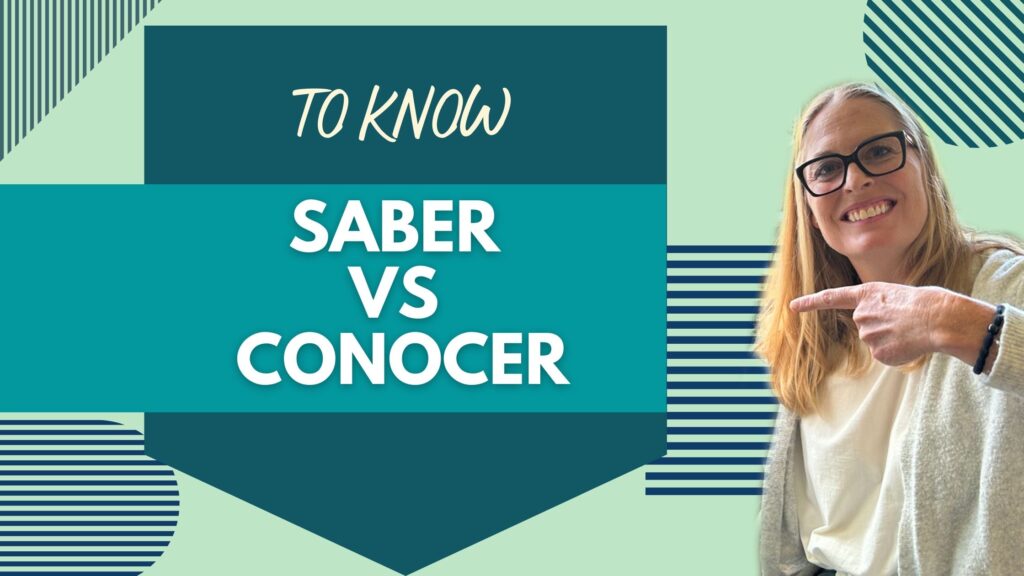Are you struggling to thrive in your Spanish class like you do in others?
There are several things you can to do help improve your Spanish grade – keep reading!
Disclaimer: If you’re a difficult student you’ve got an uphill battle to try and improve your Spanish grade. You know you’re a difficult student if:
-
- You roll your eyes and/or huff & puff frequently
- You have a “too cool for school” attitude
- You blame others instead of taking responsibility for yourself
- You are generally apathetic, disengaged or distracted in class
- You don’t complete your work and are always full of excuses why you couldn’t get it done
If one or more of the above describes you as a student, you probably need to address that (those) before you keep reading. If, however, you’re well-meaning and you are just struggling to survive in Spanish, this post is for you!
Learning Spanish (any new language) can be a daunting task in high school. There are new sounds, new letters and so many new words! Additionally, you don’t study Spanish the same way you study for a history test, or another subject that allows you to “cram”. Cramming doesn’t work if you want to learn Spanish – so you need to approach learning Spanish differently.
If you follow these simple steps below, learning Spanish will get a whole lot easier:
1. Be nice to your brain – Your brain cannot handle lots of information being thrown at it too quickly; this is why cramming for your Spanish test doesn’t work. You need to study Spanish more slowly and repetitively. Much like a musician would practice a piece of music over time to perfect it, you too should practice your Spanish over time. The average language learner needs to see a word 75 times before they learn it! That means you need to be reviewing your vocabulary every day to give your brain a chance to process it. Here is a quick actionable tip for studying Spanish vocabulary:
-
- Make sure you study Spanish terms in both language directions: Spanish – English & English – Spanish. This will help you immensely when it comes to understanding AND producing Spanish words.
2. Don’t be afraid! – Taking that step to speak Spanish (when you’re just getting started and not very familiar with the language) can be incredibly intimidating, but don’t be afraid! Fear is a big obstacle on your path to success. Use your Spanish in class whenever possible. The more you speak Spanish in class, the more comfortable you’ll get with the language. And the more comfortable you are with the language, the less you fear implementing what you’re learning in class. Once you start implementing what you’re learning you get even more confident! By simply forcing yourself to speak Spanish in as many situations as you can, you start an upward cycle of Learning – confidence – competence – more learning – more confidence – more competence…and it doesn’t stop! Here are a few phrases you could definitely use in your Spanish class that will force you to speak Spanish:
-
- Always greet your teacher with a smile and a “Buenos días” or “Buenas tardes”
- If someone sneezes say “¡Salud!”.
- If you need to borrow a pencil from a classmate, ask for it in Spanish. ¿Me presta un lápiz?
- When you need to clarify a term, ask your teacher “¿Cómo se dice____ en español/inglés?
- If you’re lost, ask your Spanish teacher “En qué página estamos?
- If you need to see a word written to get it, ask your teacher: “¿Cómo se deletrea (escribe) ____?
- You’ve got to get used to speaking Spanish if you ever want to learn it easily. Using Spanish in these situations will boost your confidence and help diminish the fear. You have to use the language to acquire it!
3. Integrate Spanish into your daily life – Spanish Immersion is one of the best ways to learn another language but isn’t always a possibility. So in lieu of traveling abroad on a Spanish immersion program, try to integrate Spanish into your life on a daily basis. There are many ways to do this:
-
- Find an artist that sings in Spanish in your favorite style of music.
- Watch a few minutes of a Spanish soap opera.
- Pick a few items in your home and look up the words for them.
- Put some sticky notes around your house and your room until you know that vocabulary 100%
Anything small thing you can do to incorporate learning Spanish into your daily routine will help your learning and keep your interest.
4. Use technology to your advantage – Smart phones are not just for texting and snap-chatting! There are tons of resources available to help you learn Spanish. Many of these apps are available online or on your mobile device. Some great resources are:
-
- Quizlet – great for studying Spanish vocabulary with flashcards and games
- YouTube – lots of Spanish tutorials about the finer points of Spanish grammar
- High School Spanish app – a great reference for writing tips, grammar, comprehension activities, Spanish flashcards and a dictionary.
- DuoLingo – great Spanish learning app
5. Ask for extra credit options – There is no guarantee here, but at the end of the day you have nothing to lose. If you’re a responsible student and not disrespectful in class or regularly blowing off your class obligations, your Spanish teacher likely will give you some second chances. Every teacher gets excited about a student finding a practical and real application for Spanish in their own lives, so if you can identify a real use for Spanish in your day to day routine, your teacher would be super-excited to give you some credit for documenting how you’re using Spanish outside of class. Give it a shot at least!
6. Get help when you need it – Spanish language concepts can be complex and usually one class session isn’t going to be enough to help you grasp it. It’s hard to admit when we are struggling and even harder to ask for help. However, chances are your teacher is more than willing to provide extra help. And the truth is that as long as you’re nice, sincere, and take personal responsibility for your own learning, your teacher will love to help you.
If you need a lot of help, and you have significant ground to cover to catch up, you may need to seek a private Spanish tutor who can work with you individually. A little bit of one on one attention can go a long way.




